View in other NatureServe Network Field Guides
NatureServe
Montana
Utah
Wyoming
Idaho
Wisconsin
British Columbia
South Carolina
Yukon
California
New York
Keeled Mountainsnail - Oreohelix carinifera
General Description
The shell is small, to 12.5 mm diameter and 7 mm in height; flattened heliciform with up to 5 whorls, umbilicus narrow and deep (contained about 4 1/2 times in the diameter), aperture oval to nearly circular, periphery strongly carinate or keeled. The surface is with coarse wrinkles but few spiral striae, the last whorl descends slightly or not at all to the aperture. Shell opaque and chalky, color is brownish-gray (dead shells to pearly white), with a series of reddish-brown spiral bands, that may be very pale or absent entirely, probably from abrasion and exposure to sunlight. Smaller shells may have a brownish cuticle that is lost in larger individuals. Head, neck, and tentacles are grayish-brown, darker than the shell (Hendricks 2012; Burke 2013). Internal anatomy described by Pilsbry (1934, 1939).
Phenology
Active in wet and cool weather; otherwise not described.
Diagnostic Characteristics
In the field best identified based upon a combination of size, location and habitat. Combination of strong keel on body whorl, absence of prominent spiral raised ridges (lirae), presence of prominent coarse and irregular growth wrinkles, and relatively small size help separate this species from other Oreohelix (Hendricks 2012; Burke 2013).
Species Range
Montana Range
Range Descriptions
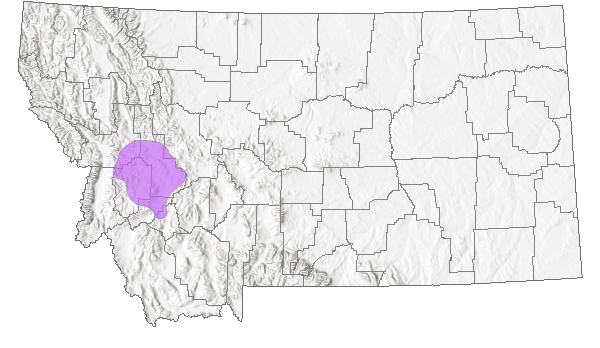
 Native
Native
Range Comments
Montana endemic: 14 records from five sites in three counties west of the Continental Divide: Granite (3), Missoula (1), Powell (1). Elevation range is 1224 to 1715 m (4015 to 5625 ft). Known localities are in the Upper Clark Fork River drainage, mostly in the corridor between Garrison Junction to Beavertail Hill State Park. Beetle (1987, 1989) retracted her report from the Big Horn Mountains of Wyoming as a misidentification of Oreohelix yavapai, although the one remaining report from east of the Divide in Park County, Wyoming needs verification. Sometimes locally abundant; as many as 140 (live and shells) found at one site in Granite County in mid May (Hendricks 2012). The original description based on specimens collected in 1907 and 1909 at Garrison Junction, Powell County.
Observations in Montana Natural Heritage Program Database
Number of Observations: 14
(Click on the following maps and charts to see full sized version)
Map Help and Descriptions
Relative Density
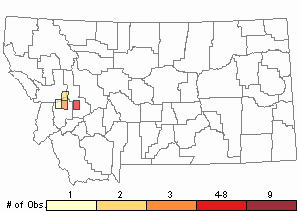
Recency
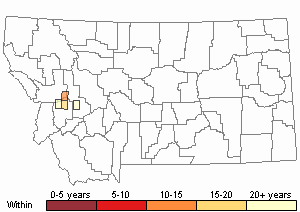

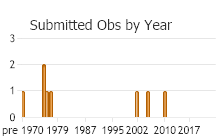
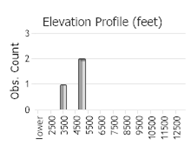 (Observations spanning multiple months or years are excluded from time charts)
(Observations spanning multiple months or years are excluded from time charts)
Migration
Non-migratory.
Habitat
Often associated with south-facing limestone talus and rocks, sometimes under an open tree canopy in relatively dry sites. Tree canopy includes Rocky Mountain juniper, ponderosa pine, and Douglas-fir. Ground cover varies but includes scattered sagebrush, Oregon grape, balsamroot, and bunch grasses. Live animals present mostly under shrubs, prostrate limbs of low-stature trees, rocks, and in duff or soil accumulations under some form of cover; sun-bleached shells may be found under rocks or on the surface (Hendricks 2012).
Food Habits
Not described.
Reproductive Characteristics
Hermaphroditic (Pilsbry 1934, 1939), otherwise not described.
Management
The known sites are on or near private timberland, Lolo National Forest land, state land, Bureau of Land Management land, and private non-timber land. None of these sites have special protection.
Stewardship Responsibility
Threats or Limiting Factors
Habitat occupied by Oreohelix carinifera may be threatened by logging, grazing, weed control, highway development, home development, and fire. Grazing and logging in the species' limited habitat, road construction and maintenance, and urban encroachment have already reduced existing populations, and drought has reduced its habitat; species is extinct over much of its remaining area due to grazing, although dead shells can still be found, suggesting recent increased impact (Frest & Johannes 1995).
References
- Literature Cited AboveLegend:
 View Online Publication
View Online Publication Beetle, D.E. 1987. The genus Oreohelix (Pulmonata: Oreohelicidae) in two western canyons of the Big Horn Mountains, Wyoming. Festivus 19(7):66-72.
Beetle, D.E. 1987. The genus Oreohelix (Pulmonata: Oreohelicidae) in two western canyons of the Big Horn Mountains, Wyoming. Festivus 19(7):66-72. Beetle, D.E. 1989. Checklist of recent Mollusca of Wyoming, U.S.A. The Great Basin Naturalist 49(4):637-645.
Beetle, D.E. 1989. Checklist of recent Mollusca of Wyoming, U.S.A. The Great Basin Naturalist 49(4):637-645. Burke, T. E. 2013. Land snails and slugs of the Pacific Northwest. Corvallis, OR: Oregon State University Press. 344 p.
Burke, T. E. 2013. Land snails and slugs of the Pacific Northwest. Corvallis, OR: Oregon State University Press. 344 p. Frest, T.J. and E.J. Johannes. 1995. Interior Columbia Basin mollusk species of special concern. Final report to the Interior Columbia Basin Ecosystem Management Project, Walla Walla, WA. Contract #43-0E00-4-9112. 274 pp. plus appendices.
Frest, T.J. and E.J. Johannes. 1995. Interior Columbia Basin mollusk species of special concern. Final report to the Interior Columbia Basin Ecosystem Management Project, Walla Walla, WA. Contract #43-0E00-4-9112. 274 pp. plus appendices. Hendricks, P. 2012. A Guide to the Land Snails and Slugs of Montana. A report to the U.S. Forest Service - Region 1. Montana Natural Heritage Program, Helena, MT. vii + 187 pp. plus appendices.
Hendricks, P. 2012. A Guide to the Land Snails and Slugs of Montana. A report to the U.S. Forest Service - Region 1. Montana Natural Heritage Program, Helena, MT. vii + 187 pp. plus appendices. Pilsbry, H.A. 1934. Notes on the anatomy of Oreohelix, III with descriptions of new species and subspecies. Proceedings of the Academy of Natural Sciences of Philadelphia 85:383-410
Pilsbry, H.A. 1934. Notes on the anatomy of Oreohelix, III with descriptions of new species and subspecies. Proceedings of the Academy of Natural Sciences of Philadelphia 85:383-410 Pilsbry, H.A. 1939. Land Mollusca of North America (North of Mexico), Volume 1, Part 1. Monograph of the Academy of Natural Sciences of Philadelphia Monograph Number 3 (1): 1-573.
Pilsbry, H.A. 1939. Land Mollusca of North America (North of Mexico), Volume 1, Part 1. Monograph of the Academy of Natural Sciences of Philadelphia Monograph Number 3 (1): 1-573.
- Additional ReferencesLegend:
 View Online Publication
View Online Publication
Do you know of a citation we're missing? Beetle, D. E. 1961. Mollusca of the Big Horn Mountains. The Nautilus 74:95-102.
Beetle, D. E. 1961. Mollusca of the Big Horn Mountains. The Nautilus 74:95-102. Hendricks, P. 2003. Status and conservation management of terrestrial mollusks of special concern in Montana. Unpublished report prepared for the U.S. Forest Service. Montana Natural Heritage Program, Helena, Montana. 67 pp. + appendices.
Hendricks, P. 2003. Status and conservation management of terrestrial mollusks of special concern in Montana. Unpublished report prepared for the U.S. Forest Service. Montana Natural Heritage Program, Helena, Montana. 67 pp. + appendices. Pilsbry, H.A. 1912. Two new American land shells collected by Messrs, Hebard, and Rehn. The Nautilus 26:88-90.
Pilsbry, H.A. 1912. Two new American land shells collected by Messrs, Hebard, and Rehn. The Nautilus 26:88-90.
- Web Search Engines for Articles on "Keeled Mountainsnail"
- Additional Sources of Information Related to "Snails / Slugs"





